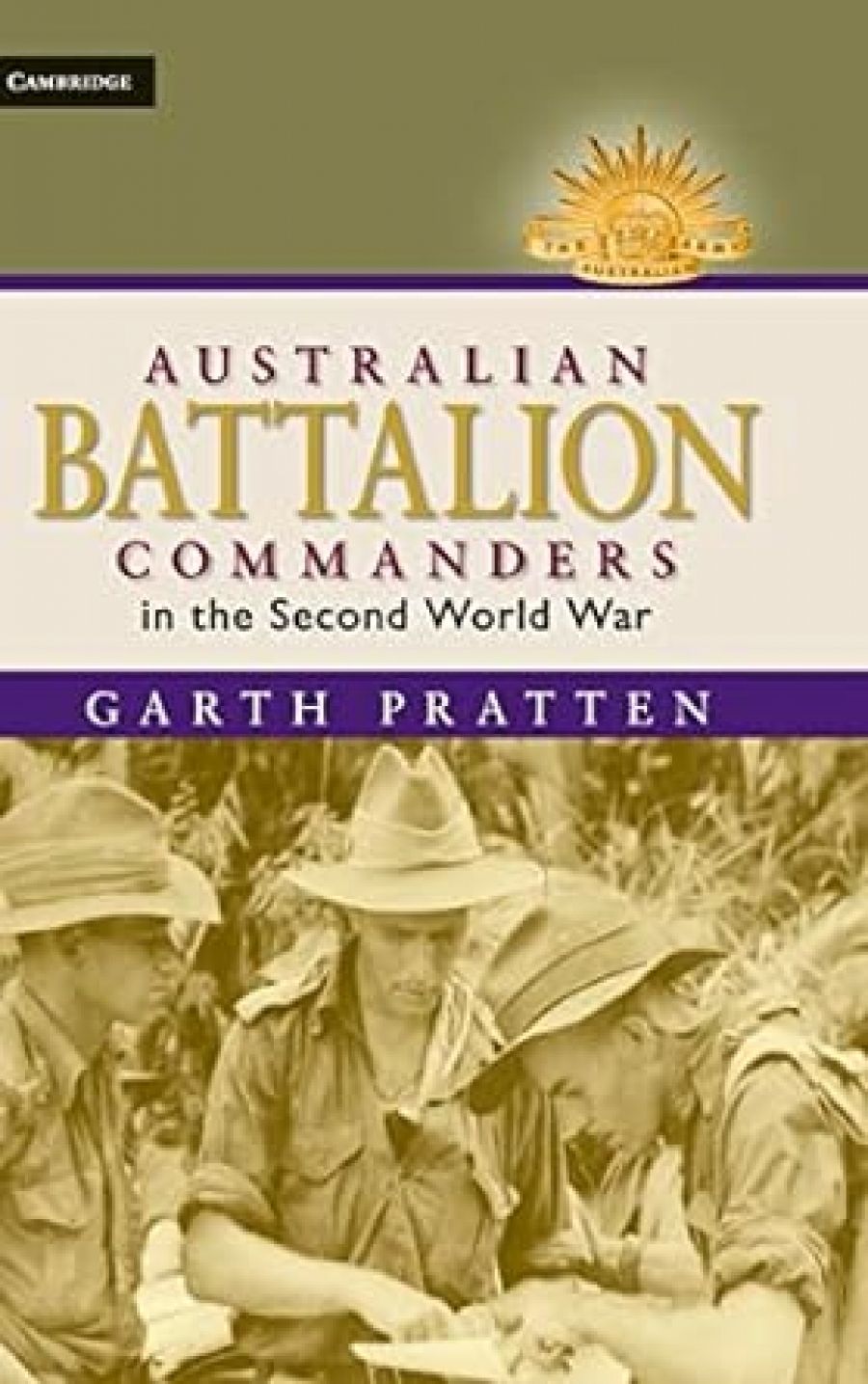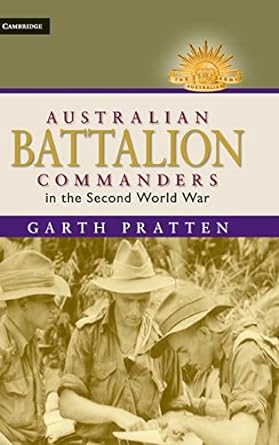
- Free Article: No
- Contents Category: Military History
- Review Article: Yes
- Article Title: A man called Myrtle
- Online Only: No
- Custom Highlight Text:
Do not be put off by this book’s bland title. In a country that has placed the Anzac Legend at the centre of its national identity, Australian Battalion Commanders in the Second World War is a profoundly subversive book. Cherished ideas of the Australian army as an egalitarian institution and of Australians as natural soldiers whose setbacks can always be blamed on the failings of others (generally the British or the Americans) are put to the test and found wanting. Those looking to have their strident assertions of Australian nationalism validated will be disappointed, but there are already plenty of other Australian military books that can satisfy them. Garth Pratten provides a portrait of Australians at war that is less heroic and more ambiguous, but ultimately more realistic because more human.
- Book 1 Title: Australian Battalion Commanders in the Second World War
- Book 1 Biblio: Cambridge University Press, $59.95 hb, 435 pp
- Book 1 Cover Small (400 x 600):

Australia ended World War I with a battle-hardened corps of five infantry divisions that had played an important role in the victory on the Western Front in 1918; but it did not have an army prepared for combat when World War II began in 1939. The Permanent Military Forces of full-time soldiers was tiny; the militia of part-time soldiers was undermanned and underequipped. The army high command chose militia officers with World War I experience to create and train the infantry battalions that would serve overseas in the Second Australian Imperial Force. Each battalion consisted of around eight hundred men, and was the largest army organisation in which the commander had personal contact with the soldiers under his command.
Despite all that has been written about the egalitarianism of the Australian Army, the battalion commanders were chosen in 1939 according to their possession of what Pratten describes as ‘a wide range of middle-class values’. An analysis of the social backgrounds of all 276 Australian battalion commanders (COs) in World War II shows that this middle-class bias continued for the rest of the war. Three quarters of COs were urban white-collar workers, when only a quarter of the male population as a whole came from this group. At a time when the majority of Australian males had no schooling after the age of fourteen, seventy per cent of COs had completed their high school matriculation. While only one per cent of males had university degrees, forty-two per cent of COs did. This middle-class bias in selecting COs meant that only two per cent were tradesmen. None was a labourer. The overwhelmingly urban background of battalion commanders also gives lie to the legend of the Australian soldier as bushman: twenty-two COs were clerks before enlistment, but only two had been jackeroos.
Recruits need to be trained in order to fight, and Australians in World War II were no different, despite all that has been said about Australians as natural soldiers. World War I veterans appointed to command battalions had no understanding of modern mobile warfare, and their initial training prepared recruits to refight the last war rather than to fight the current conflict. Fortunately for the battalions of the 6th, 7th and 9th Divisions in the Middle East, World War I veterans were all replaced by 1941, and their successors attended British army officer schools, where they learnt about current military operations before gaining their own combat experience. The battalions of the 8th Division in Malaya were not as lucky.
Pratten is scathing in his criticism of 8th Division commanders, arguing that they all ‘lacked the experience and imagination required to match an enemy of the quality of the Imperial Japanese Army’. Without the British army schools that their counterparts in the 6th, 7th and 9th Divisions had attended in the Middle East, they continued to make the same mistakes on exercise in Malaya that they had made in Australia. The 8th Division COs did not realise the importance of their battalion’s anti-tank guns, which was unfortunate as tanks spearheaded the Japanese advance into southern Malaya in January 1942. During the final battle for Singapore, several COs led their battalions so badly that they ceased to exist as fighting organisations, assisting the Japanese in their conquest of the island.
Pratten contrasts these failures in command in the 8th Division in Malaya and Singapore at the beginning of 1942 with the seasoned actions of 9th Division commanders at the Battle of Alamein in Egypt at the end of that year. These experienced COs had learned to devolve most decisions to their junior officers, but also knew when to intervene and when to take a calculated risk. The fighting at Alamein was intense, and Australian casualties were high, but, unlike Singapore, the battalions remained cohesive units.
In the Pacific War from 1942 to 1945, the battalion commanders’ actions were often determined by political pressure from the Australian government. In Papua in 1942, COs were forced to attack quickly in order to eject the Japanese from Australian territory. This led to many Australian soldiers dying unnecessarily in hasty and ill-prepared attacks. These men might have been spared had commanders been able to spend time scouting the Japanese positions and ascertaining the best assault route. In the final campaigns of 1945 in New Guinea and the Dutch and British colonies in Borneo – which were less about defeating Japan then they were about resuscitating pre-war colonial authority – the Australian government’s pressure on commanders was to avoid casualties. This brought its own difficulties, as a tentative attack could result in more casualties rather than fewer. In 1945 the years of conflict also began to take their physical and psychological toll on battalion commanders. At least nine had to be replaced due to what Pratten describes as ‘combat exhaustion’.
Australian Battalion Commanders in the Second World War is grounded in a wide knowledge of leadership in its general sense, and military command in particular. Pratten’s careful analysis of Australian commanders is supported with comparisons to the World War II American, British, Canadian and New Zealand armies. What makes this book stand out, however, is the author’s ability to bring the battalion commanders to life (despite a surprisingly incomplete archival record: the Australian army destroyed World War II officers’ confidential reports in the 1970s, and gaps in unit diaries mean that it is impossible to know exactly who was commanding some militia battalions early in the war). Pratten shows that battalion commanders came in all types, and those who appeared to be the least military were often the most effective leaders. This is best illustrated by Lieutenant Colonel T.H. Walker, the first commander of the 2/7th Battalion (a unit known to a certain generation of Australian television viewers as the battalion which Tom Sullivan, Norm Baker and Bert Duggan joined in The Sullivans). A mild-mannered, short man with a squeaky voice, the soldiers called him ‘Myrtle’. At first, senior officers doubted his ability to command a battalion, but Walker proved a calm and consistent leader who gained and retained his men’s loyalty and respect. During the disastrous campaigns in Greece and Crete, the 2/7th Battalion remained a disciplined unit to the end. The men of the battalion, left behind on Crete, opted not to split into small groups and try to escape separately, but chose to remain a formed unit under Walker’s command and to fight their way out together. Most, including Walker, became prisoners of war.
Military discipline is not a quality that is associated with the Anzac Legend, but what this book suggests is that the Australian experience of war may be less about natural soldiers, larrikinism and insubordination, and more about training, command and the loyalty a group of men felt toward a man they called ‘Myrtle’.


Comments powered by CComment